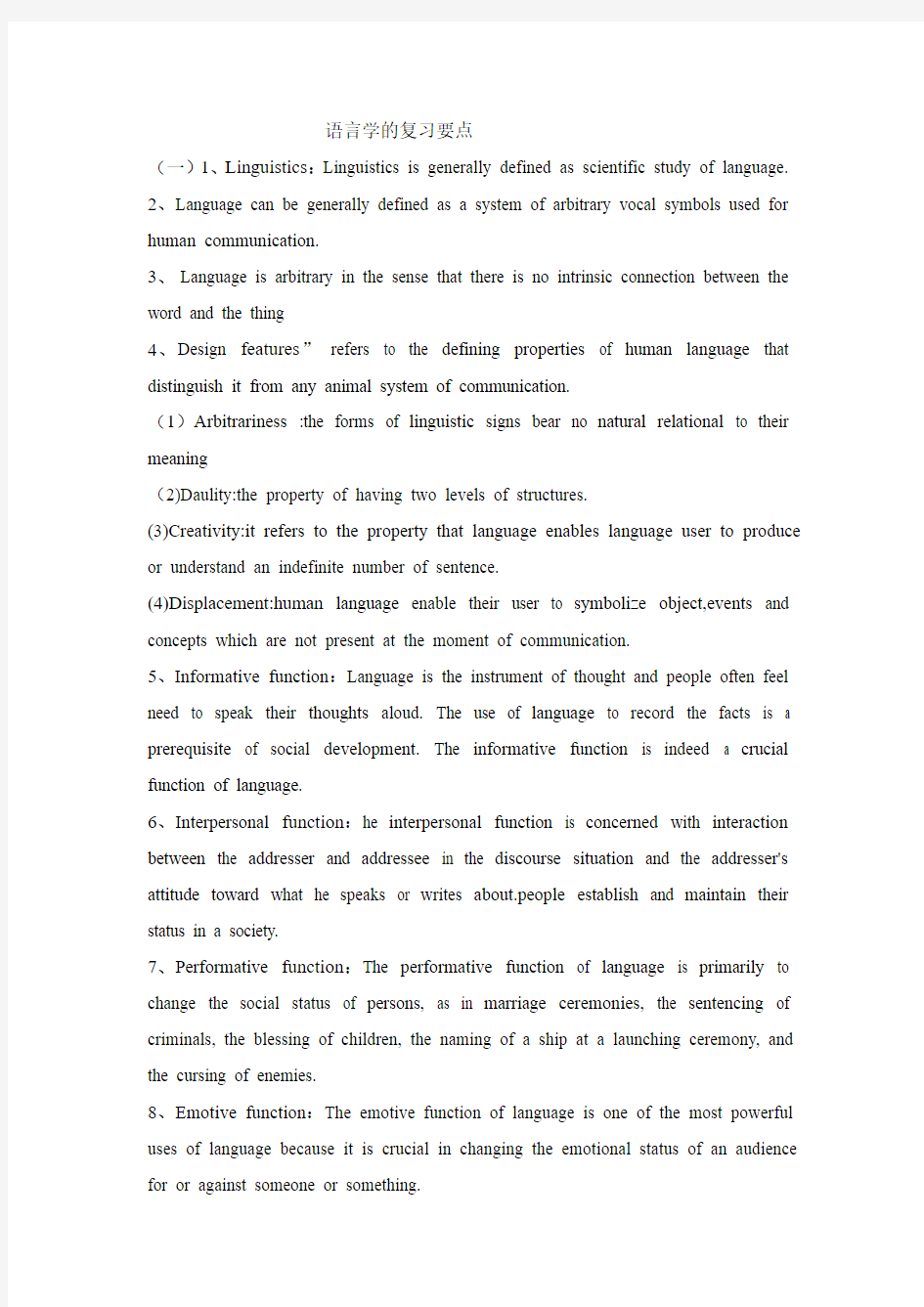语言学复习要点

- 1、下载文档前请自行甄别文档内容的完整性,平台不提供额外的编辑、内容补充、找答案等附加服务。
- 2、"仅部分预览"的文档,不可在线预览部分如存在完整性等问题,可反馈申请退款(可完整预览的文档不适用该条件!)。
- 3、如文档侵犯您的权益,请联系客服反馈,我们会尽快为您处理(人工客服工作时间:9:00-18:30)。
语言学的复习要点
(一)1、Linguistics:Linguistics is generally defined as scientific study of language.
2、Language can be generally defined as a system of arbitrary vocal symbols used for human communication.
3、Language is arbitrary in the sense that there is no intrinsic connection between the word and the thing
4、Design features”refers to the defining properties of human language that distinguish it from any animal system of communication.
(1)Arbitrariness :the forms of linguistic signs bear no natural relational to their meaning
(2)Daulity:the property of having two levels of structures.
(3)Creativity:it refers to the property that language enables language user to produce or understand an indefinite number of sentence.
(4)Displacement:human language enable their user to symbolize object,events and concepts which are not present at the moment of communication.
5、Informative function:Language is the instrument of thought and people often feel need to speak their thoughts aloud. The use of language to record the facts is a prerequisite of social development. The informative function is indeed a crucial function of language.
6、Interpersonal function:he interpersonal function is concerned with interaction between the addresser and addressee in the discourse situation and the addresser's attitude toward what he speaks or writes about.people establish and maintain their status in a society.
7、Performative function:The performative function of language is primarily to change the social status of persons, as in marriage ceremonies, the sentencing of criminals, the blessing of children, the naming of a ship at a launching ceremony, and the cursing of enemies.
8、Emotive function:The emotive function of language is one of the most powerful uses of language because it is crucial in changing the emotional status of an audience for or against someone or something.
9、Phatic communion:Phatic communion refers to the social interaction of language
10、Recreational function
11、Phonetics:studies speech sounds, including the production of speech, that is how speech sounds are actually made, transmitted and received, the description and classification of speech sounds, words and connected speech.
12、Phonology: studies the rules governing the structure, distribution, and sequencing of speech sounds and the shape of syllables.
13、Morphology is concerned with the internal organization of words. It studies the minimal units of meaning —morphemes and word-formation processes.
14、Morphemes serve different purposes. Some derive new words by changing the meaning or the part of speech, others only refine and give extra grammatical information about the already existing meaning of a word.
15、Syntax is about principles of forming and understanding correct sentences. The form or structure of a sentence is governed by the rules of syntax, which specify word order, sentence organization, and the relationships between words, word classes and other sentence elements.
16、Semantics examines how meaning is encoded in a language. It is not only concerned with meanings of words as lexical items, but also with levels of language below the word and above it, e.g. meaning of morphemes and sentences.
17、Pragmatics is the study of meaning in context. It deals with particular utterances in particular situations and is especially concerned with the various ways in which the many social contexts of language performance can influence interpretation. In other words, pragmatics is concerned with the way language is used to communicate rather than with the way language is internally structured.
(二)
1、Phonetics mainly deals with the description, classification and transcription of speech sounds.
2、Phonology explores the patterns that govern the combination of sounds, i.e, it studies how speech sounds are grouped together to convey meaning in linguistic communication
